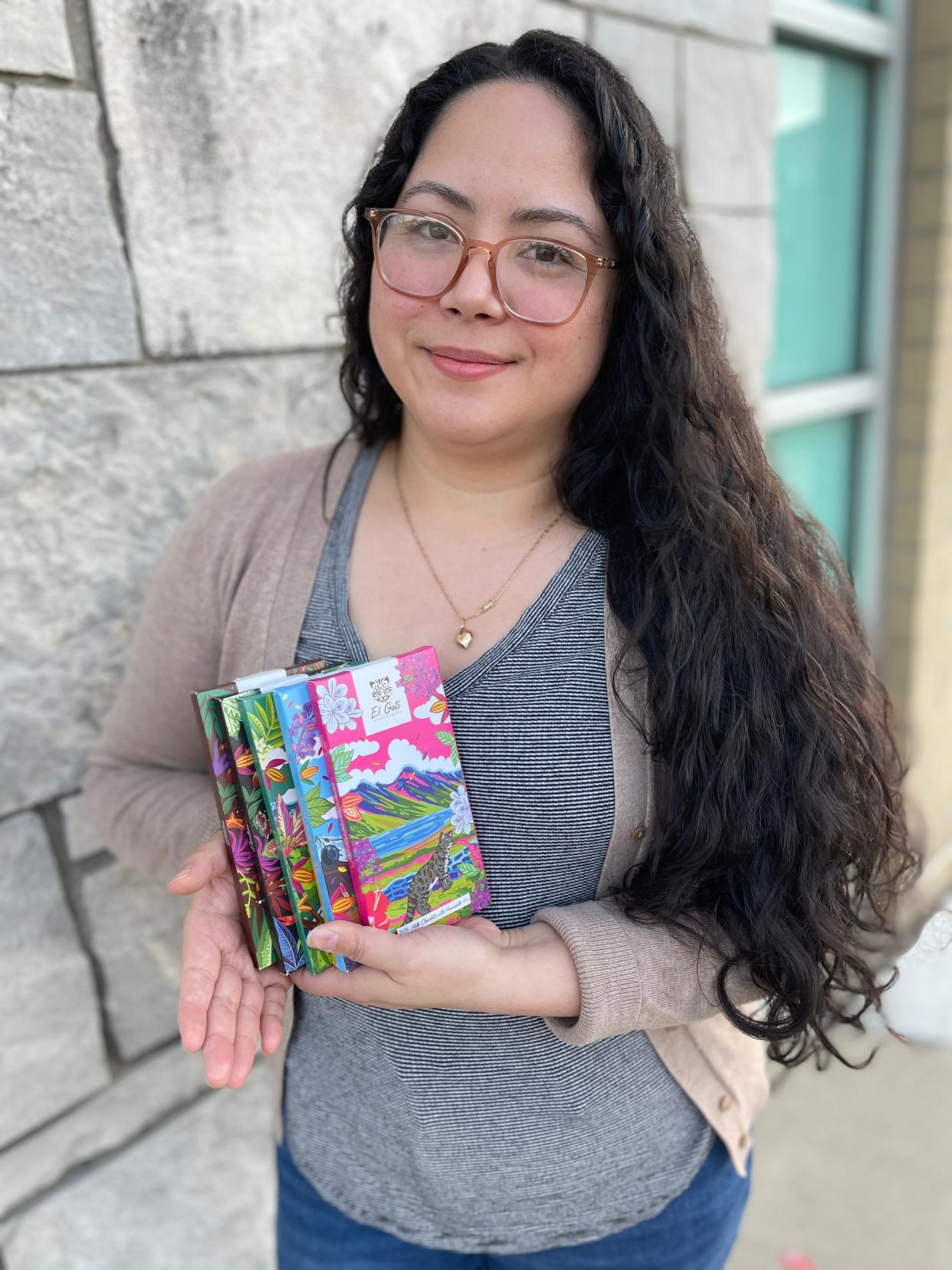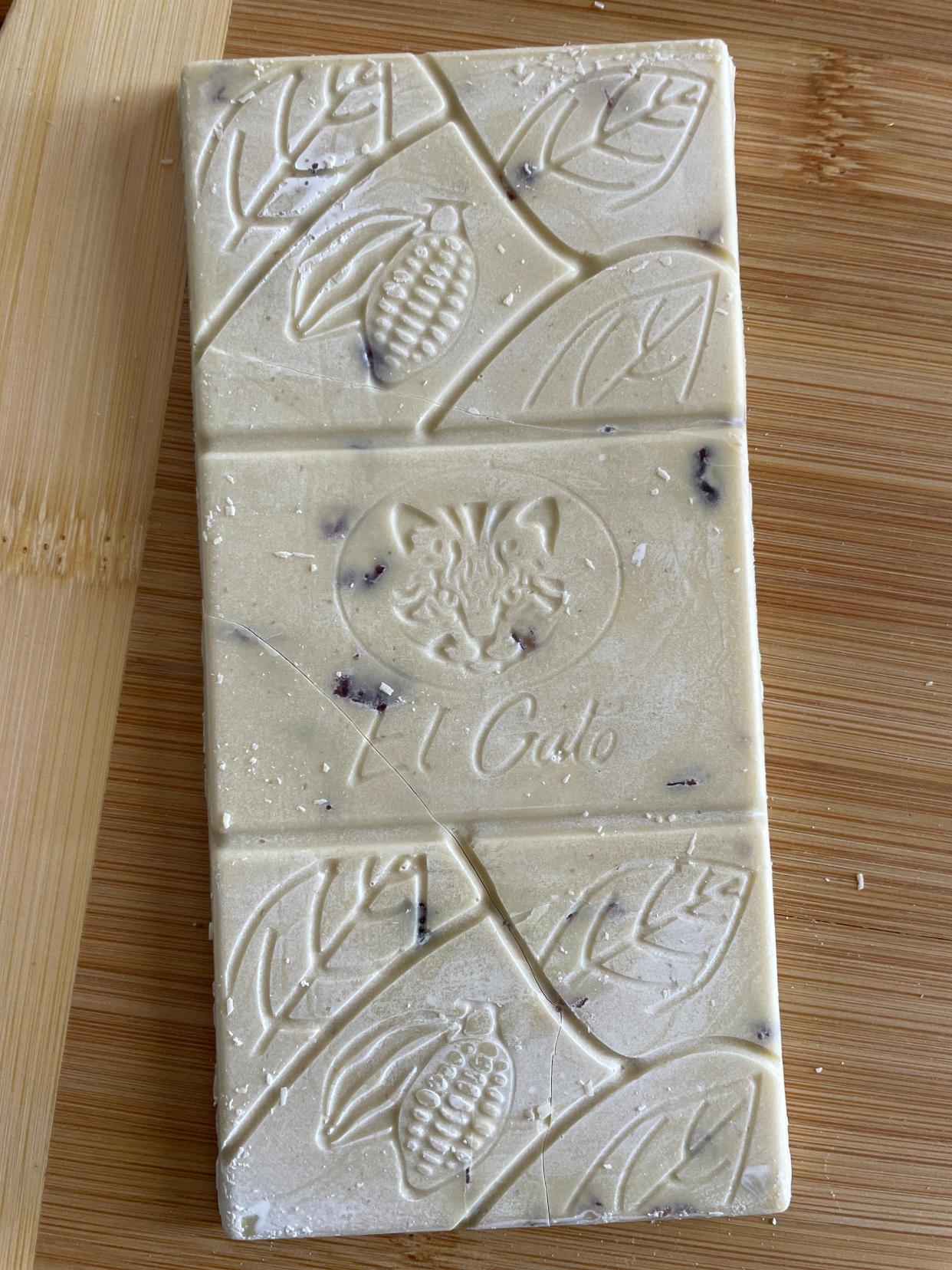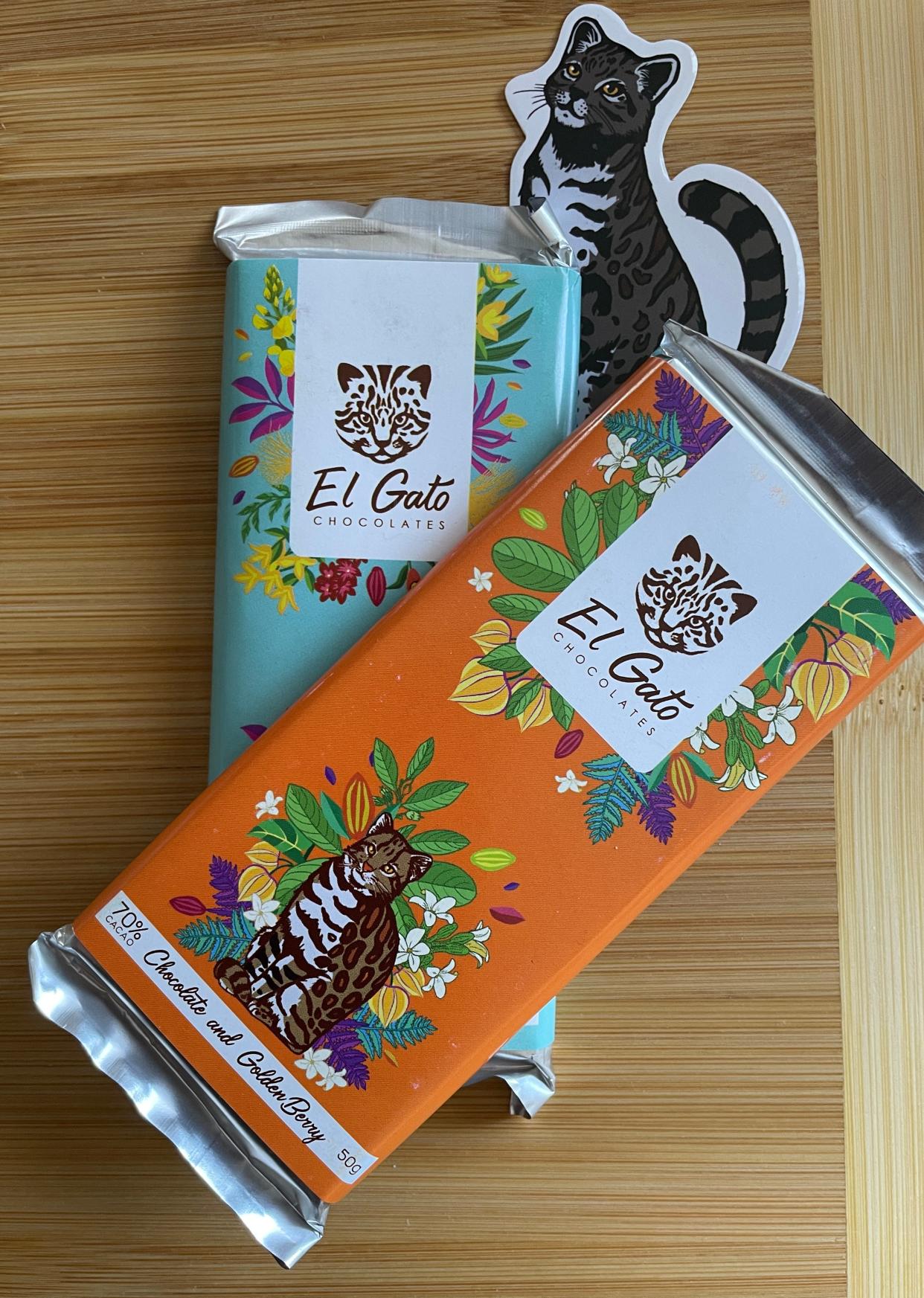El Gato’s bean-to-bar chocolates support farmers and wildcats in Peru

Some of Gabriela Vasquez’s favorite memories take her back to her family roots in Peru. As a girl, she happily watched while her grandmother would prepare chocolate from the cacao beans that grew in their town. Her favorite treats would include that chocolate and coffee from locally grown beans.
When Vasquez moved to Miami to live with her father and attend college, she started thinking about ways to stay connected to her hometown in Peru. While the San Martin jungle region was long known for farming cacao and coffee, decades ago many farmers had been forced to grow coca for the drug industry. Slowly, they began bringing back more cacao and coffee farming.
Vasquez considered how she could help the farmers and her family, along with the locally endangered wildcats in Peru. Teaming up with a friend who works with the farms and a factory in Peru, in 2017 she began her bean-to-bar chocolate company: El Gato Chocolates.
Beginning with organically grown cacao, El Gato Chocolates use no preservatives or additives. Options range from 100% bitter and 73% dark to milk chocolate, with additions of coffee, peanuts, quinoa, golden berries or amaranth, plus a white chocolate with Peruvian blueberries. Prices range from $4 to $9.
Each molded bar features an imprint of an endangered wildcat, while colorful labels highlight endangered wildcats or pampas cats in distinct regions of Peru. Vasquez has partnered with South American organizations, including the Andean Cat Alliance and the Peruvian Desert Cat Project, and donates 10% of profits to help the endangered cats.

Vasquez moved to the Milwaukee area in 2021 to be closer to her husband’s family. She continues to sell El Gato Chocolates online, shipping nationwide. She’s also selling chocolate at local farmers markets select dates this summer season, including the Riverwest Market, 2700 N. Pierce St. (opens June 2), Kenosha Harbor Market at 2nd Ave. and 56th St. in Kenosha (opens May 11), and the Milwaukee Night Market on W. Wisconsin Avenue between 2nd Street and N. Phillips Avenue on Aug. 14.
Her inspiration is close to home
I grew up eating chocolate made by my grandma. She would make it in the craft way, get the cacao from nearby farmers and dry it, toast it, the whole process. She did it the same way with coffee. I grew up literally drinking natural chocolate and natural coffee. My mom used to say we stopped drinking our milk bottles for chocolate and coffee.
My whole town, 20 to 30 years ago, narco trafficking was a big problem. They were forced to to grow coca leaves. They didn't want to do the coca leaves. Nothing good comes from that. Eventually they switched to cacao and coffee, as they were doing before.
When I’d go visit my family in Peru, I'd always go visit farmers and check the cacao. I was really into it. When I was in college I would sell chocotejas, like a Peruvian bon bon. I’d only make it with organic chocolate from my hometown, never chocolate from the stores. That's how I got more interested in the process of chocolate, not just cacao. Every time I would go to Peru I'd try different chocolate bars, bring some back, make friends taste it. Then I learned to make it. Over the years, it was a hobby that became something that I wanted to do. That's how in 2017 when I went to Peru I talked to my friend. Her dad was already involved in cacao farming. She's the neighbor of one of my uncles. We reconnected over cacao. "Let’s start a business, you’re interested in the farming part, and I am interested in the product itself. I live in the United States, and we can bring the export there."
What it means to be small batch and bean to bar
The chocolates are all made and packaged in Peru. We worked with a cooperative, an organization for over 200 farmers that grow cacao in my hometown. What this organization does is collect all the cacao from the different farmers, including ours. So now we are growing cacao, our own trees and fruit pods, and the seeds are collected. They do the fermentation and drying process. We buy the beans that were dried. We do the toasting process in small batches.
Why is it important to do small batches? Because we carefully check the beans are not burned. Then we separate the shells on the outside of the cacao and grind it until it gets smooth. We add the sugar and process overnight. We make sure it gets very smooth. It is a handmade molding process. We have four employees.
One thing she’ll never include in her chocolate
I will never make chocolate with caramel, even though I know people love it. That is too sweet.
I want people to enjoy chocolate and get the nutrients. For me, chocolate is a treat. I want people to taste the cacao, to smell the fruit and try to distinguish taste. Sometimes the cacao tastes a little more floral, sometimes more licorice. Those flavors change and depend on the season. Our cacao comes from the same region, but if it rains too much, the flavor is different. The cacao that grows at a little higher altitude is more floral. I want people to see if they can taste that in the bars.
What you should know about that chocolate you’re eating, and why you might pay more
Right now, this is a very vulnerable market for chocolate businesses, especially small businesses. The chocolate is affected by climate change, affecting growing cacao and the things you obtain to make chocolate. On the other hand, we have these big corporations that make chocolate that is not really chocolate. They make it with lots of ingredients and the prices are really cheap. I would like people to understand the chocolate business is not easy, especially if you care about nature, your farmers and your community. If people start to learn more about how to get from fruit form to the chocolate bar, the bean-to-bar process, they will understand behind every chocolate bar is a whole community working really hard every day to make it happen. You can help everyone behind that bar.
What differentiates the flavors of El Gato Chocolates
We have eight flavors, sweetest to darkest, then white chocolate with blueberry, which is not made with entire cacao, just the cacao butter and blueberries, and cane sugar. We don't use vanilla, because for me it changes the flavor. We don't use any artificial flavors or additives. No soy lecithin or any oil. We don't do that. That is why the chocolate lasts for a year. Eat it before the year ends.
We have milk chocolate with amaranth, a small grain. We have golden berry, a Peruvian golden berry, it looks like a tomatillo, but now you can find it everywhere. We have dark with 73% cacao, dark 85%, and bitter, which is 100%. Then chocolate with coffee beans. The coffee is from my hometown, too. The peanuts grow in my hometown, and blueberries grown on the south side of Peru. Someday if we open a store here, we'd use fruits from here, like raspberry or cherries. My husband loves those.

Behind the El Gato name
Everyone is familiar with the word cat in Spanish. I always loved wildcats. We have one in my hometown, tigrillo, also known as ocelot. We have pumas ... When I was in school we always had campaigns about protecting the wildcats. I found out about one organization that helped to protect wildcats in South America, the Andean Cat Conservation. Ever since I was a kid I’d donate. ... When I created the business, I reached out and asked if I could do a partnership and help them with our chocolates. They helped me create the packaging to make sure I project the Andean cats. We have representation of four cats now: Andean cat, pampas cat, ocelot and Geoffroy's cat.
One lesson she’s learned
Be patient, especially if you want a great product. You also have to be willing to accept the “no." When we started people tried it and said, “It is not as sweet as Snickers,” or it doesn’t taste like chocolate they know. I would have to elaborate and take a minute to teach them that this is real chocolate.
An important note about storing chocolate
This chocolate, never keep it in the fridge, please. Keep it in a dry, dark place, with a temperature not over 68 degrees. Make sure it is away from other vegetables and fruit, especially onions, because chocolate absorbs the flavors.
Fork. Spoon. Life. explores the everyday relationship that local notables have with food. To suggest future personalities to profile, email clewis@journalsentinel.com.
This article originally appeared on Milwaukee Journal Sentinel: Milwaukee's El Gato Chocolates supports farmers and wildcats in Peru






